is a liberal arts institution located in Brunswick.
In June 1794 Massachusetts Governor Samuel Adams signed an act to establish Bowdoin College promoted by James Bowdoin III, who gave financial support to its formation and named it in honor of his father, James Bowdoin II.
Massachusetts Hall, Bowdoin’s first building was constructed, with delays, between 1798 and 1802. Winthrop Hall, built in 1822, the original wooden chapel, also served as the library. In 1820, the Medical School of Maine was established as part of Bowdoin. The school awarded more than 2000 degrees during its existence from 1820 to 1921.
Nathaniel Hawthorne graduated from Bowdoin in 1825. His first novel, written in 1828 and titled Fanshawe, was set at a college similar to Bowdoin. Hawthorne went on to write The Scarlet Letter, The House of Seven Gables and the campaign biography for his friend Franklin Pierce, Bowdoin class of 1824 and 14th President of the U.S.
“We wish to plead our own case. Too long have others spoken for us. Too long has the public been deceived by misrepresentations in things which concern us deeply.” These words, appearing in the March 16, 1827 inaugural issue of Freedom’s Journal, were written by John Brown Russwurm, Bowdoin’s first black graduate, in 1826. The third [or second, sources vary] black to graduate from an American college, he went on to become the co-founder and co-editor of the country’s first black newspaper, Freedom’s Journal.
Congregational clergyman and author Elijah Kellogg was a graduate in 1840.
Harriet Beecher Stowe’s Uncle Tom’s Cabin was published in 1852. Stowe’s husband, Calvin, who was in the class of 1824, was Collins Professor of Natural and Revealed Religion at the College, and Stowe wrote much of her book in his study in Appleton Hall, while they lived in that is now the historic Stowe House on the National Register of Historic Places in Brunswick.
Henry Wadsworth Longfellow taught modern languages at Bowdoin from 1829 to 1835 and was arguably the most popular literary figure in nineteenth century America.
Colonel Joshua Lawrence Chamberlain, class of 1852, took command of the 20th Maine Infantry in 1863. He defended Little Round Top at the Battle of Gettysburg, later receiving the Congressional Medal of Honor for his actions. Ellis Spear, another Bowdoin graduate, was Chamberlain’s second in command at Gettysburg.
Oliver Otis Howard born in Leeds, Bowdoin Class of 1850, was a Civil War hero. He founded Howard University in 1867 and served as the school’s first president from 1869 to 1874. Bowdoin’s residence hall, Howard Hall, is named for him.
After the war, the College contended that a larger percentage of Bowdoin’s alumni fought in the Civil War than those of any other college in the North. And many worked behind the scenes as well, most notably Governor Andrews of Massachusetts, Bowdoin Class of 1837, who was responsible for forming the famous 54th Massachusetts regiment of black soldiers.
In 1894 the Walker Art Building, funded by Harriet Sarah and Mary Sophia Walker, was completed. The nation’s leading architectural firm of the time, McKim, Mead and White, designed the museum in the Renaissance Revival style. Housing the Bowdoin Art Museum, it was renovated and expanded in 2007.
Robert E. Peary, class of 1877, reached the North Pole in 1909. Donald B. MacMillan of the class of 1898 led one of Peary’s support teams. Peary returned to the United States a national hero and was promoted to the rank of rear admiral. MacMillan went on to lead more than two dozen expeditions to the Arctic, often enlisting Bowdoin College students as members of his scientific crew.
Bowdoin made national headlines two times in 1970 by making the College Board’s Scholastic Aptitude Tests optional and by voting to admit women to the College. Bowdoin’s Afro-American Center opened and in 1978 was named for Bowdoin’s first black graduate, John Brown Russwurm, class of 1826.
In 1997 Bowdoin adopted an innovative House System which connects all first-year students with upper-class houses, and includes all students in a system designed to build and deepen the learning community at the College. Coles Tower residence and dining facility, built in 1964, at sixteen floors is by far the tallest building for miles around.
Its Coastal Studies Center in Harpswell opened in 1998, providing research opportunities for its faculty and staff, and a nature preserve with hiking trails for the public.
Olympic gold medalist Joan Benoit Samuelson is a Bowdoin graduate, as was poet Robert P.T. Coffin.
Others among Bowdoin’s graduates are George J. Mitchell, U.S. Senator and Senate Majority Leader; William S. Cohen, U.S. Senator and Secretary of State; John Fairfield, Congressman, U.S. Senator, and Governor; Congressman and U.S. Senator William Pierce Frye; and Elijah Kellogg, author and clergyman. U. S. Representatives: Thomas H. Allen, Thomas H. Andrews, John Appleton, Samuel Page Benson, James Ware Bradbury, Ephraim W. Farley, Samuel Clement Fessenden, Thomas Fessenden, William Pitt Fessenden, Peter Garland, Robert Hale, Simon Hamlin, John D. McCrate, Daniel J. McGillicuddy, Edward C. Moran, Jr., James Oliver, John Otis, John Andrew Peters (1864-1953), Frederick A. Pike, Thomas Brackett Reed, Benjamin Randall, Cullen Sawtwlle, Donald F. Snow, Lorenzo de Medici, and Wallace White, Jr.
On May 7, 1964 Dr. Martin Luther King, Jr. visited the college, after a stop at St. Francis College, now the University of New England, in his only trip to Maine.
Additional resources
Bowdoin College www.bowdoin.edu
“2004 MAINE’S MOST ENDANGERED HISTORIC PROPERTIES” http://www.mainepreservation.org/Endangered/index.shtml
Anderson, Patricia McGraw. The Architecture of Bowdoin College. photographs by Richard Cheek. Brunswick, Me. Bowdoin College Museum of Art. 1988.
Bowdoin College, 1802-1952: the Commemoration of the Opening of the College. Brunswick, Me. Bowdoin College. 1952.
Brown, Philip Henry. “Education and Politics: an Address read to the Portland Alumni of Bowdoin College at their Annual Dinner January 4, 1872.” Portland, Me. B. Thurston and Co. [1872/].
Calhoun, Charles C. A Small College in Maine: Two Hundred years of Bowdoin. Brunswick, Me. Bowdoin College. 1993.
Cleaveland, Nehemiah. History of Bowdoin College: with Biographical Sketches of its Graduates, from 1806 to 1879, inclusive. edited and completed by Alpheus Spring Packard. Boston. J. R. Osgood. 1882.
Coursen, Elizabeth Huntoon. Brunswick and Bowdoin College: Postcard History Series. Charleston, SC. Arcadia Publications. c2009.
French, George. 1937 black and white photos from the George French Collection. Maine State Archives.
*Maine. Historic Preservation Commission. Augusta, Me. Text from National Register of Historic Places: http://pdfhost.focus.nps.gov/docs/nrhp/text/71000042.PDF
Sills, Kenneth C. M. Joseph McKeen (1757-1807) and the Beginnings of Bowdoin college, 1802. New York. The Newcomen Society of England, American Branch. 1945.
Slattery, Charles Lewis. “Brunswick and Bowdoin College.” New England Magazine. 1891, pp. [449] – 469.
National Register of Historic Places – Listings
Massachusetts Hall
In 1794, the Massachusetts Legislature approved the creation of Bowdoin College. In 1798, the two Boards of the College voted to erect the first college building. John Dunlap of Brunswick chaired the building committee. After the walls of brick brought from Portland were raised, the structure was secured until funds could be found for completion. The College trustees owned five townships in north-central Maine and in 1801 they sold two of them, Foxcroft and Dixmont, allowing construction to resume.
The hall was ready for occupancy by the spring of 1802; it was named Massachusetts Hall at the inauguration of the first president of the college on September 2, 1802. In 1836, a cupola, which had served as a bell tower, was removed from the top of the Hall. In 1873 the two top stories were made into a single room called the Cleaveland Cabinet in honor of respected professor Parker Cleaveland. A new raised roof and a gallery reached by two spiral staircases were added. A second story was added on the east side to form an entrance hall and staircase to the Cleaveland Cabinet.
In 1936 the building was remodeled as administrative offices; in 1942 the third floor was restored and finished as a faculty room.* [See photo above.]


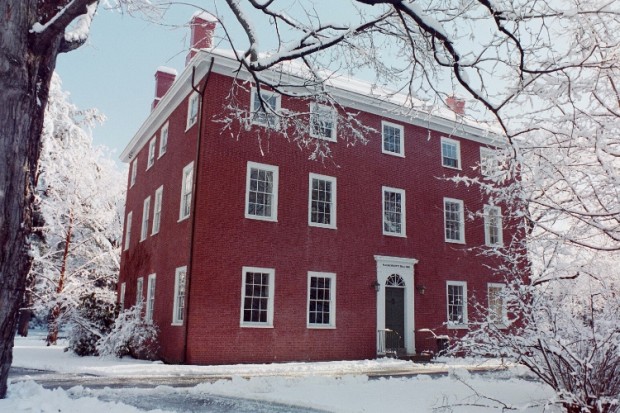
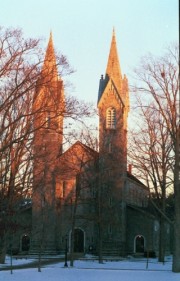
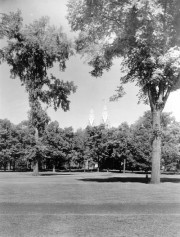
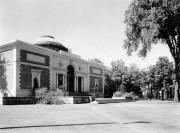
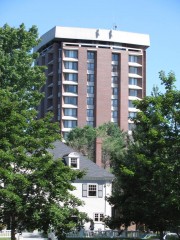
Dear Bowdoin Librarian:
I am trying to locate information about a book by poet Robert P. Tristram Coffin titled DEW & BRONZE, published in 1927 by Albert & Charles Boni in order to find out if it was illustrated by author John A. Wedda.
Any help you could offer would be greatly appreciated.
Sincerely,
Karen Mireau
This is not the Bowdoin College site. All articles are elements of maineanencyclopedia.com.
However, Bowdoin does have a substantial collection of Coffin’s material.
Go to https://library.bowdoin.edu/arch/mss/rptcg.shtml
Click on “About Us,” then “Staff” for contact information.